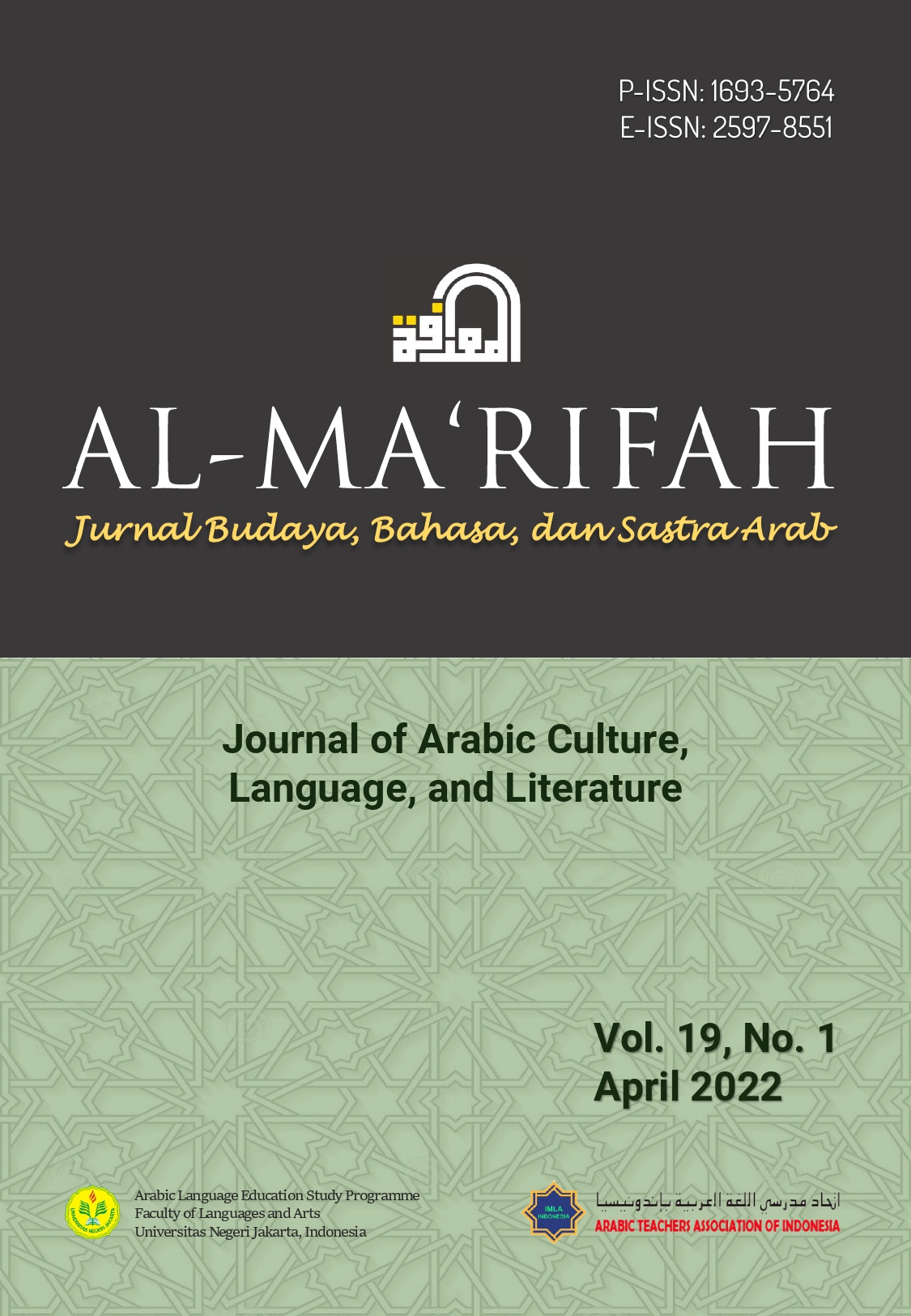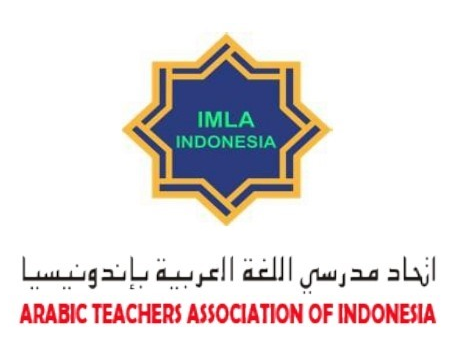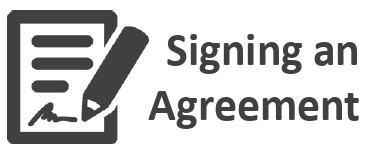al-Af‘āl al-Kalāmīyah al-Injāzīyah ‘inda Searle fī al-Qiṣṣah al-Qaṣīrah Lu’lu’at al-Ṣabāḥ li-Kāmil Kīlānī
DOI:
https://doi.org/10.21009/almakrifah.19.01.09Keywords:
Illocutionary, speech acts, Searle’s theory, pragmaticAbstract
This study aims to describe the various forms and functions of the illocutionary speech acts that contained in the Kāmil Kīlānī’s short story Lu’lu’at al-Ṣabāḥ. This research uses pragmatic approaches in descriptive qualitative studies. Using reading and taking notes as data collection techniques, and data reduction, data presentation techniques and making conclusion as data analysis techniques. The results of this study showed that there are five forms of speech act contained in conversations between the short story’s characters of Lu’lu’at al-Ṣabāḥ by Kāmil Kīlānī, namely assertive, directive, commissive, expressive, and declaration. The details are that there are 10 assertive speeches, 10 directive speeches, 2 commissive speeches, 1 expressive speech, and 1 declarative speech. And there are 11 functions of illocutionary speech act contained in the short story Lu’lu’at al-Ṣabāḥ by Kāmil Kīlānī: there are 2 speech functions of explaining, 3 speech functions of stating, 2 speech functions of telling, 3 speech functions of affirming, 4 speech function of advising, 4 speech function of requesting, 2 speech function of warning, 2 speech function of offering and threating, 2 speech function of sadness and setting.
References
Anggraeni, S. F., Tajuddin, S., & Nuruddin. (2018). Expressive speech acts and cultural values in collection of short stories Wahah Al-Asdiqa’. el Harakah: Jurnal Budaya Islam, 20(1), 99–112. doi:10.18860/el.v20i1.4828
Ana, G. H., & Chotimah, D. N. (2018). Searle’s speech act in Hamdan bin Muhammad’s tweets on Twitter. In Y. Rahman, I. Riyani, Kusmana, D. Darmawan, I. F. S. R. Khairani, & J. Rohmana (Eds.). Quran Hadith studies, information technology and media: Challenges and Oppurtunities. Proceeding of the 2nd International Conference on Quran Hadith (ICONQUHAS) with the 1st International Conference on Islam, Science, and Technology (ICONIST) (pp. 384–390). Bandung, Indonesia. Retrieved from https://eudl.eu/doi/10.4108/eai.2-10-2018.2295540
Badriyah, L. (2019). al-Af‘āl al-kalāmīyah fī film cartoon Ḥasan ibn al-Haytham (Skripsi, UIN Maulana Malik Ibrahim, Malang). Retrieved from http://etheses.uin-malang.ac.id/15265/
Black, E. (2006). Pragmatick stylistics. Edinburgh: Edinburgh University Press.
Cruse, A. (2006). A glossary of semantics and pragmatics. Edinburgh : Edinburgh University Press.
Fogal, D., Harris, D. W., & Moss, M. (Eds.). (2018). New work on speech acts. Oxford: Oxford University Press.
Hudiyono, Y. (2021). Wacana percakapan instruksional: Kajian struktur, strategi, dan fungsi. Yogyakarta: CV Istana Agency.
al-Ḥasnāwī, F. Dh. Gh. (2016). al-Ab‘ād al-tadāwulīyah ‘inda al-Uṣūlīyīn: Madrasat al-Najaf al-ḥadīthah unmūdhajān. Beirut: Markaz al-Ḥaḍārah li-Tanmiyat al-Fikr al-Islāmī.
Idrus, M. (2009). Metode Penelitian ilmu sosial pendekatan kualitatif dan kuantitatif. Jakarta: Erlangga.
Irfan, M. (2018). al-Af‘āl al-kalāmīyah fī film Wajdah li-Hayfā’ al-Manṣūr (Skripsi, UIN Sunan Ampel, Surabaya). Retrieved from http://digilib.uinsby.ac.id
Khitām, J. (2016). al-Tadāwulīyah: Uṣūluhā wa-ittijāhātuhā. Amman: Kunūz al-Ma‘rifah.
Kīlānī, K. (2007). Lu’lu’at al-Ṣabāḥ. Cairo: Dār Maktabat al-Aṭfāl.
Mulyani. (2020). Praktik penelitian linguistik. Yogyakarta: Deepublish.
Muyassarah, & Abadi, J. (2021). Klasifikasi puisi Arab Jahiliyah menurut Ibn Qutaybah dalam kitab al-Shi‘r wa-al-Shu‘arā’. Al-Ma‘rifah: Jurnal Budaya, Bahasa, dan Sastra Arab, 18(1), 77–86. doi:10.21009/almakrifah.18.01.07
Parera, J. D. (2004). Teori semantik (2nd ed.). Jakarta: Erlangga.
Romadoni, M. A. (2020). al-Af‘āl al-kalāmīyah al-tawjīhīyah fī khuṭbat Ṭāriq ibn Ziyād ‘inda fatḥ al-Andalus: Dirāsah taḥlīlīyah tadāwulīyah (Skripsi, UIN Maulana Malik Ibrahim, Malang). Retrieved from http://etheses.uin-malang.ac.id/21480/
Ronda, A. M. (2018). Tafsir kontemporer ilmu komunikasi: Tinjauan teoritis, epistemologi, aksiologi. Tangerang: Indigo Media.
Searle, J. R. (1969). Speech acts: An essay in the philosophy of language. Cambridge: Cambridge University Press.
Setiawati, E., & Arista, H. D. (2018). Piranti pemahaman komunikasi dalam wacana interaksional: Kajian pragmatik. Malang: Universitas Brawijaya Press.
Simbolon, M. E. (2019). Tuturan dalam pembelajaran berbicara dengan metode reciprocal teaching. Surabaya: Media Sahabat Cendekia.
al-Ṭabaṭabā’ī, Ṭ. S. H. (1994). Naẓariyat al-af‘āl al-kalāmīyah bayn falāsifat al-lughah al-mu‘āṣirīn wa-al-balāghiyīn al-‘Arab. Kuwait: Maṭbū‘āt Jāmi‘at Kuwayt.
Wibowo, W. (2006). Berani menulis artikel: Babak baru kiat menulis artikel untuk media massa cetak. Jakarta: Gramedia Pustaka Utama.
Wibowo, W. (2009). Menuju jurnalisme beretika: Peran bahasa, bisnis, dan politik di era mondial. Jakarta: Kompas Media Nusantara.
Yule, G. (1996). Pragmatics (H. G. Widdowson, Ed.). Oxford: Oxford University Press.
Downloads
Published
How to Cite
Issue
Section
License
Copyright (c) 2022 Fihalisa Mughi Tri Alya, Dien Nur Chotimah

This work is licensed under a Creative Commons Attribution 4.0 International License.











